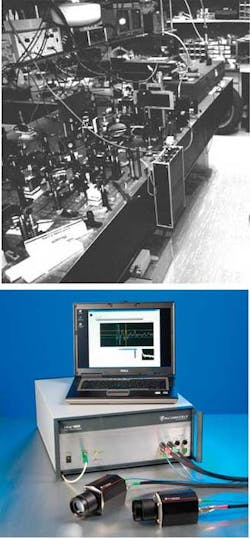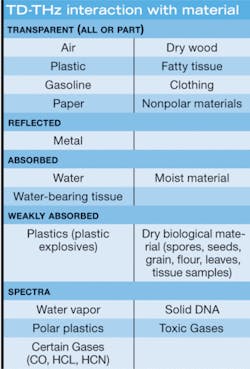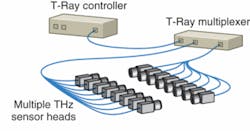TERAHERTZ IMAGING: Compact TD-THz systems offer flexible, turnkey imaging solutions
IRL DULING AND DAVID ZIMDARS
Applications from homeland security to pharmaceutical quality control are uniquely enabled by time-domain terahertz (TD-THz) methods that use subpicosecond near-single-cycle electromagnetic impulses. These hyper-wide-band impulses, spanning frequencies from less than 40 GHz to more than 3 THz, provide unique capabilities to exploit this region of the electromagnetic spectrum. Time-domain terahertz instrumentation combines the capabilities of ultra-high-resolution radar, noncontact ultrasound, and far-infrared spectroscopy. The technique can be used for a wide range of sensing, compositional analysis, and subsurface imaging applications.
Wide industrial deployment of TD-THz sensing requires integration of turnkey systems. Instrumentation must be easily configured by the vendor or the customer, without undue concern for its inner workings, leaving the focus on the application. Time-domain terahertz radiation is generated and detected photonically, which can be difficult to deploy in an industrial environment if free-space optics are required. Use of fiber-optic coupling allows a system to have interchangeable terahertz transmitters, receivers, and waveform scanners. A user can choose instrument capabilities as required by the application, or the vendor can provide an all-in-one turnkey solution. The latest generation of TD-THz instrumentation brings the benefits of terahertz sensing to the broader industrial market.
Advantages of time-domain terahertz
Terahertz pulses have many useful properties unique to both the region of the spectrum and the single-cycle nature of the field. Most dielectric materials are weak absorbers of terahertz radiation in comparison to the mid-IR (see table). This capability enables pulsed terahertz radiation to be used for deep subsurface interrogation of optically opaque media. Nondestructive imaging can be performed in transmission or reflection mode, relying on differences in absorption and/or refractive index. Equally important, many substances have measurable, unique spectral signatures due to phonon interactions, molecular rotations, and other low-energy excitation modes. These properties allow terahertz radiation to image systems and objects within sealed packages such as paper, cardboard, plastic, and ceramics, and to determine their composition and density by using spectroscopic frequency and intensity analysis.Time-domain terahertz pulses have several significant advantages over methods at other frequencies that possess some of these same characteristics. Terahertz radiation is completely nonionizing, with photon energies more than six orders of magnitude less than soft x-rays. Most terahertz applications require less than one microwatt of power. So terahertz radiation is completely safe for use by humans or on human subjects.
With a wavelength shorter than microwaves, terahertz pulses provide higher-resolution images—the diffraction limit for 3 THz radiation is less than 250 µm. Moreover, terahertz images feature much lower scatter levels than are typical with infrared imaging. Three-dimensional reflection images similar to ultrasound are enabled by the single-cycle pulses, but can be made at standoff distances of meters.
The hyper-wide bandwidth eliminates interference fringes that distort single-frequency images. Time-of-flight measurements can measure thickness with high dynamic range, without regard to exponential attenuation. Time-domain-terahertz receivers are essentially blind to electromagnetic interference from infrared heat or radio waves.
Terahertz applications generally require a complete system of terahertz generation, detection, data collection, and analysis. Time-domain terahertz instrumentation provides not only a robust method for generation of terahertz pulses, but also a naturally integrated high-sensitivity, high-speed method for detection and waveform collection. While there are several alternative technological approaches for terahertz generation (backward-wave oscillators, parametric frequency generation, and molecular-gas laser), each has its own drawbacks in terms of size, portability, and cost. Room-temperature continuous-wave terahertz detectors have poor responsivity and can be susceptible to background interference, requiring high-power sources. In contrast, the time-gated detector of the TD-THz system provides high-dynamic-range detection with a low-power drive.
Most commercial TD-THz systems generate pulses by irradiating a voltage-biased, photoconductor-based antenna with ultrafast laser light. These laser pulses have typical durations of less than 0.2 ps. Time-domain THz detection is performed with a similar, but unbiased, antenna device. It generates a quasi-DC photoconductive signal when synchronously irradiated by the terahertz electric field and an ultrafast laser pulse. The terahertz receiver time gate is swept using a variable optical-delay line. A trace of the terahertz waveform is generated similarly to a sampling oscilloscope at rates between 20 Hz and 4 kHz.
There are several advantages to this approach. First, because of the high peak intensity and natural time-gating of the detector, the signal-to-noise ratio (S/N) of such a system can be very high, allowing for very sensitive detection. The latest turnkey systems, for example, deliver S/N of more than 75 dB at their peak frequency. In addition, the short pulse duration translates into a very broad spread in the frequency domain, enabling spectroscopic analysis through simple Fourier transform of a transmitted or reflected waveform. And, just as important, the time gating of the detector provides natural time-of-flight information enabling 3-D imaging, with depth resolution better than 50 µm.
Technology platform
The current generation of TD-THz systems relies on a platform of interchangeable components, interconnected through fiber-optic coupling that takes advantage of the near-infrared wavelength of the ultrafast laser pulses. Permanently aligned miniature terahertz transmitter and receiver modules are packaged to Telcordia telecommunication standards and have integrated bias and preamplifier electronics. Such fiber-coupled modules allow the freely positionable terahertz sensor heads to be located up to 30 meters from the system, and even mounted on scanning stages for imaging applications.
In comparison to first-generation free-space terahertz instruments, the second- and third-generation instruments removed the limitations of preconfigured static optical transport. Nevertheless, a potential drawback of these systems was the need for the user to purchase, operate, and maintain an ultrafast laser that was free-space coupled into the system. Complete systems with lasers, even when configured all in one enclosure, were the size and weight of a small refrigerator.
Technology has moved quickly, and fourth-generation systems take advantage of advances in compact, hands-free ultrafast laser technology (see Fig. 1). A rack-mountable system weighs less than 50 lb and includes the ultrafast laser; a high-resolution, high-speed waveform scanner; and an internal stand-alone data-acquisition system integrated within the unit. The results of waveform analysis (for example, weight and moisture content) can be directly reported in real time (100 Hz). No external equipment, other than a laptop computer, is needed to conduct terahertz measurements.
The fourth-generation Picometrix TD-THz platform works hand-in-glove with a suite of fiber-optic-coupled interchangeable terahertz transmitter, receiver, and all-in-one sensor heads. A standard base control unit allows two-channel operation (signal and reference, for example). An eight-channel multiplexer option allows simultaneous operation of multiple pairs of sensor heads driven by a single control unit (see Fig. 2). This modular approach supports multiple measurements at different sites on a production line or to perform array measurements, avoiding the need for multiple instruments. The built-in controller can also drive external scanners to provide high-speed imaging.Diverse applications
Applications for TD-THz instrumentation span numerous industries. For example, moisture-content measurement is of interest for pharmaceutical and food manufacturing and processing. Terahertz sensing can uniquely perform these measurements, through packaging, at high speed, which is important for both industries. In pharmaceutical manufacturing, many tablets are coated with a moisture-barrier layer and manufacturers need to assess moisture content in the tablet after this layer has been applied. Similarly, the shelf life of processed and baked foods is often highly dependent on moisture content.
Other applications include chemical analysis and trace detection of gases, liquids, and solids—also of interest to the chemical industry for security purposes. Because the sampling window is only picoseconds in duration and these systems can sample at rates up to 4 kHz, the latest systems are ideal for monitoring reactions, curing, and drying dynamics in real time. These are important advantages for on-line monitoring during pharmaceutical production, which is currently transitioning from batch processing to continuous production. Other applications use TD-THz radiation to measure density (or concentration) and dry weight, as well as to determine structural integrity by imaging hidden defects and voids.
Two applications powerfully demonstrate the practical utility of TD-THz detection: baggage screening and measuring the integrity of foam on the space-shuttle external fuel tank (see Fig. 3).Under the Manhattan II Program, the United States Department of Homeland Security has been investigating different technologies to screen checked airline baggage, and TD-THz detection has demonstrated several advantages. Because it can probe baggage in transmission and reflection modes, terahertz sensing can produce 3-D images from a limited number of views, rather than requiring axial computed tomography. Also, the waveforms can be analyzed to detect or preferentially highlight certain materials.
NASA’s Return-To-Flight program, following the space shuttle Columbia disaster, required nondestructive evaluation of the insulating foam on the external fuel tank. This terahertz application uses back-reflection measurements and is enabled by the fiber coupling of the transceivers, simplifying the scanning of such a large structure. The high resolution and contrast in low-density foam is a significant benefit in this application.
Irl Duling directs terahertz business development and David Zimdars manages terahertz research and development at Picometrix (an Advanced Photonix company), 2925 Boardwalk, Ann Arbor, MI 48104; e‑mail: [email protected]; www.picometrix.com.



